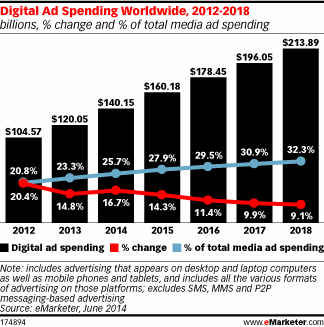Digital ads are projected to make up one quarter of all global ads by 2016, and that number will only continue to grow. Just in the U.S, digital ads have almost reached 30% of total ads, and the UK reached the 50% milestone last month. Digital ad spending has steadily increased every year for the past decade, and it is clear that online marketing has sealed its position as a legitimate investment.
But there are still some late adopters that have yet to fully embrace digital media, And those are the companies that we at Polygraph love to help.
One of our clients, focused on driving traffic to retail storefronts, relied heavily on Valpak to create coupons and other print media. The problem is, what kind of people actually use printed coupons? An older demographic that has been slower to transition to the digital age. Not really the market this client wanted to reach. Since working with Polygraph, however, that client has found we can reach a much younger demographic online, cut down their conversion costs, and still drive these people to physical stores.
Printed coupons are just one of many traditional media formats that are falling behind in the digital era, or struggling to transition online. According to Kantar Media, in 2014, spending on newspaper ads decreased 10 percent, magazine ads fell 5.1 percent, and radio ad spending declined 3.9 percent. Traditional advertising channels are declining slowly, and digital is rising fast.
So should you ditch your traditional media efforts and completely switch to digital? No,not yet. You could probably allocate more resources to digital, but just like Facebook Ads vs. Google Adwords, each channel (in this case offline and online) have their own advantages. Chris Treadaway, CEO here at Polygraph, connects the need for multiple media types to portfolio theory, an economic theory that says instead of investing heavily in one stock, you invest in several and benefit from diversification. In short, don’t put all your eggs in one basket. With several assets (or channels), you minimize overall risk. So, you should keep your traditional media efforts along with digital.
What does digital have that traditional doesn’t? As we talked about in the last blog post, Facebook has the power to directly target ads. Using users’ demographics, search history, page likes, retweets, shares, favorites, etc., you can find potential interested consumers and target an ad towards them yourself. Direct targeting is not possible when mass broadcasting commercials. With broadcasting, it’s spray n’ pray - hoping you connect with someone interested. With digital, you know you’ll hit your target. Conversion costs are also much lower. Paying $1.60 for a click is more cost-effective than over $1 million for a TV commercial. Also, as our client learned with Valpak, print media is most popular among older demographics. To reach a younger audience, messages these days are sent through digital channels.
The perks of digital marketing continue to be unlocked as technology improves and marketers continue to innovate. Almost all forecasts are that the mobile channels will continue to grow, and traditional channels will shrink. The marketing landscape is ever-changing, and marketers will always be forced to make adjustments. With the rise of this digital era, it is clear that marketers need to add digital media to their asset portfolio.




Leave A Comment
You must be logged in to post a comment.